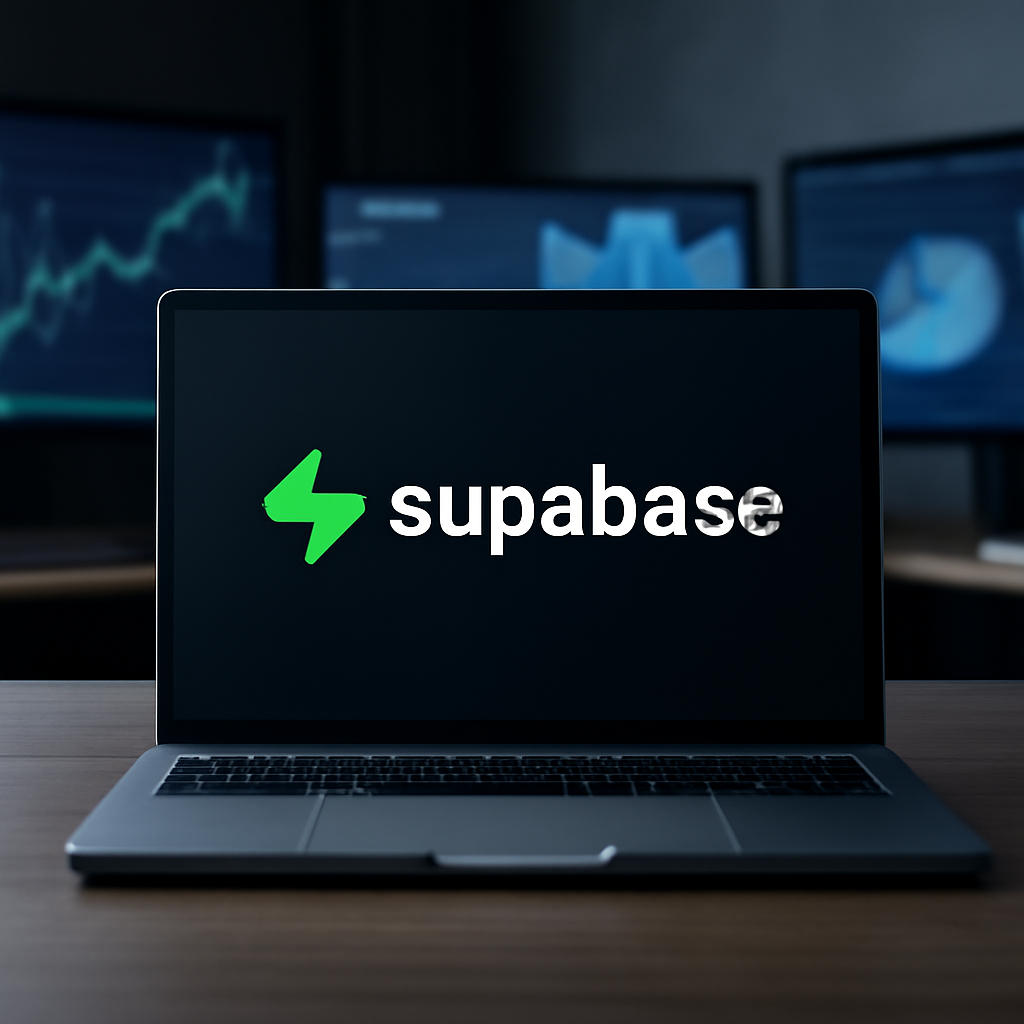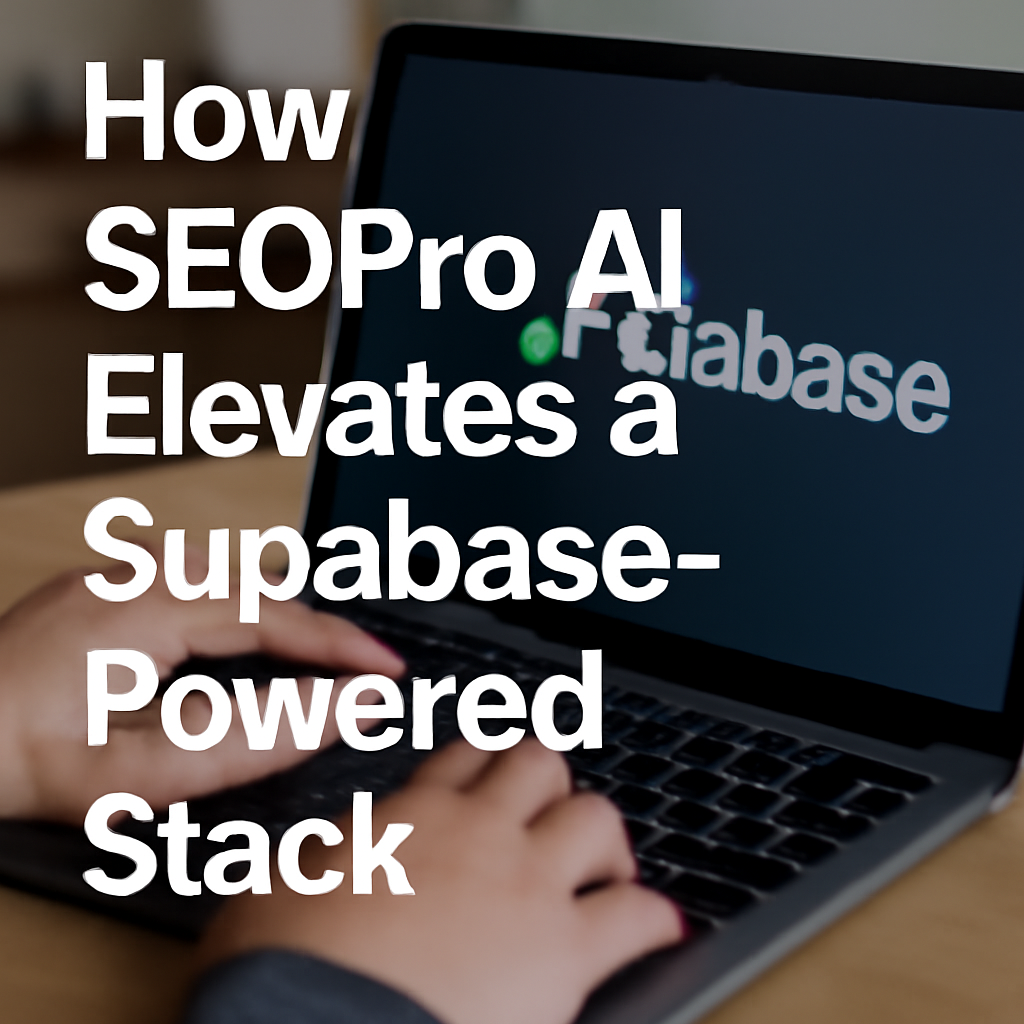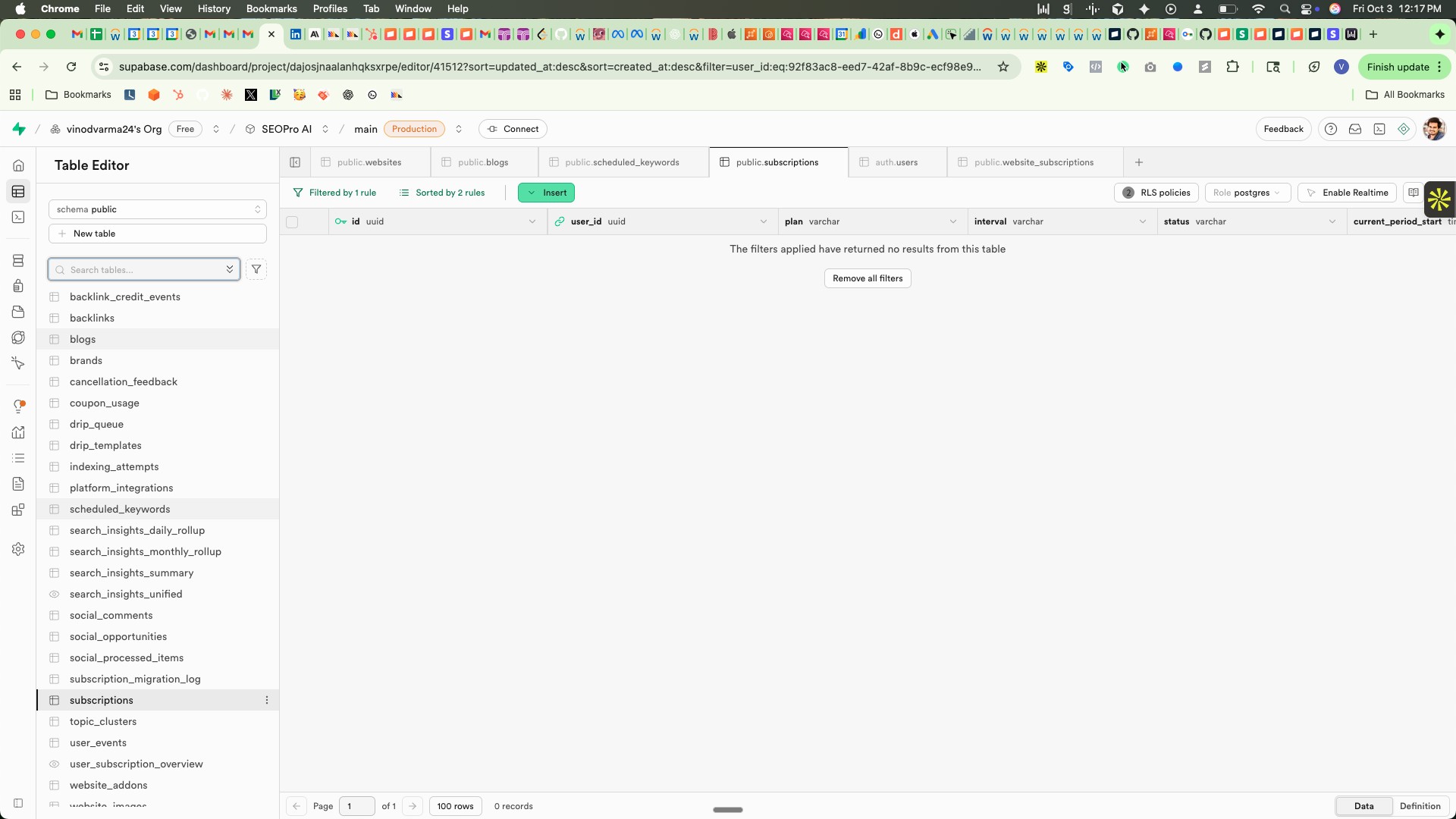Reading time: 12 minutes • Audience: website owners, digital marketers, content creators, and product teams exploring modern data backends
Choosing the right data backbone shapes how fast you ship, how confidently you scale, and how safely you protect customer trust. Supabase gives you a production-grade PostgreSQL foundation plus authentication, realtime capabilities, storage, and vector search in one integrated platform. If you are building a content platform, analytics dashboard, or membership site, you want a stack that balances speed with rigor. In this guide, you will learn how to design a secure, scalable data layer, where it shines, where to be cautious, and how to pair it with Artificial Intelligence (AI)-driven Search Engine Optimization (SEO) operations.
As you read, keep your growth goals in focus. Databases do not live in isolation; they power signups, content workflows, reporting, and delightful experiences. We will connect engineering choices to commercial outcomes using examples from SEOPro AI, an Artificial Intelligence (AI)-driven Search Engine Optimization (SEO) platform that provides AI-driven content optimization, research, and content marketing support. By the end, you will have a practical blueprint for storing app data with clarity, safety, and room to grow.
Why Choose Supabase for App Data
At its core, Supabase is built on PostgreSQL, a relational database trusted globally and ranked among the top four engines by industry indexes. That means you get Atomicity, Consistency, Isolation, Durability (ACID) guarantees, mature extensions like PostGIS for geospatial work, and familiar Structured Query Language (SQL) for analytics. Beyond the database, you receive authentication tied directly to your tables, file storage for images and media, realtime subscriptions for collaborative features, and vector functions for semantic search. For teams that want to move quickly without assembling dozens of cloud services, that integrated bundle removes friction.
Speed does not have to sacrifice portability. Because your project is standard PostgreSQL, you can export data freely, use established drivers, and integrate with popular Object-Relational Mapping (ORM) tools. Security starts at the table with Row Level Security (RLS), an approach that enforces data access at the database layer instead of scattering rules across your code. For many businesses, especially those running content and community sites, this model reduces bugs and audit risk. The result is a platform that works for a weekend prototype yet stays credible when traffic spikes.
- Familiar query language and tools reduce onboarding time for new developers.
- Integrated authentication and authorization cut custom boilerplate and security debt.
- Realtime updates help you build live dashboards, chats, and collaborative editing.
- Vectors unlock semantic search, recommendations, and retrieval for content-heavy apps.
Supabase Architecture Essentials
Understanding the building blocks helps you map features to your use case. The database is standard PostgreSQL, which means you can join, aggregate, and index data using proven patterns. An auto-generated Application Programming Interface (API) layer exposes RESTful endpoints mapped to your tables and views, so you can prototype quickly without scaffolding controllers. Authentication manages signups, logins, and sessions with policy hooks that integrate with Row Level Security (RLS). Storage lets you save and serve files, while realtime broadcasting streams changes to clients that are subscribed to specific channels or tables.
Watch This Helpful Video
To help you better understand Supabase, we’ve included this informative video from Fireship. It provides valuable insights and visual demonstrations that complement the written content.
Finally, vector support stores and indexes embeddings, so your application can search by meaning rather than exact keywords. Many marketing and publishing products combine this with content metadata to power discovery and improve internal search. If you prefer flexibility, you can write server-side logic using functions or edge compute to keep secrets safe. Together, these components form a cohesive surface that avoids the swivel-chair work of stitching services across multiple clouds, yet remains portable because the heart of the system is PostgreSQL.
| Component | What It Does | Example in Content Platforms |
|---|---|---|
| PostgreSQL Database | Relational storage with transactions, indexes, and extensions | Articles, authors, categories, and analytics events with joins for fast reports |
| Authentication | User accounts and session management tied to database policies | Members-only content, paywalls, and moderation tools |
| Storage | Object buckets for images, videos, and documents with access rules | Hero images, downloadable whitepapers, podcast audio |
| Realtime | Live change streams for subscribed clients | Live dashboards for traffic, comments updating as users type |
| Vectors | Embedding storage and similarity search | Semantic content search and related-article recommendations |
| Auto-generated Interface | REST endpoints mapped to tables and views | Rapid prototypes and admin tools without scaffolding controllers |
Data Modeling, Security, and Governance
Good models are the difference between easy growth and persistent headaches. Start by identifying core entities such as users, content, media assets, and events, then map relationships with clear foreign keys and indexes. Use narrow tables for frequently updated facts and wider materialized views for reports, so writes remain fast while analytics stays responsive. Enforce constraints, apply check rules for allowed values, and prefer explicit timestamps for audits. This gives you a foundation that makes errors unlikely and reporting reliable, which is crucial when your brand reputation rides on accurate data.
Security belongs in the center of your plan. Row Level Security (RLS) policies keep user data isolated by default, and table privileges limit what service accounts can do. Encrypt sensitive fields at rest, rotate secrets on a schedule, and log access with a retention policy aligned to the General Data Protection Regulation (GDPR) or the Health Insurance Portability and Accountability Act (HIPAA) where applicable. Keep file access behind signed URLs instead of public links. With these controls in place, you reduce the chance that a single code bug exposes personal data, and you make compliance audits far less stressful.
- Define a naming convention for tables, columns, and roles before you create the first table.
- Write tests for policies; simulate malicious access, not just happy paths.
- Partition large event tables by time and add composite indexes for frequent filters.
- Use materialized views for dashboards that need sub-second refresh without heavy queries.
Performance, Scalability, and Cost: A Practical View

Performance is a product decision as much as an engineering exercise. Start with a baseline: connection pooling for chatty clients, indexes for critical filters, and read replicas for hot queries. Measure p95 latency for write-heavy endpoints and use explain plans to catch full table scans before they bite. Realtime streams are powerful, but you should scope subscriptions narrowly to avoid noisy updates. For vector search, set sensible dimensions and approximate indexes where appropriate, then bound result counts to protect response times.
Cost predictability matters to every business. Typical starter tiers are accessible for side projects, and you can add capacity as you grow. Because the core is PostgreSQL, you avoid a hard pivot later if your data needs become more complex. However, any system can get expensive if schema and query patterns are not curated. Budget a few hours each month for housekeeping: prune unused data, revisit indexes, and retire unneeded realtime channels. Those habits keep performance steady and bills civilized, especially during marketing campaigns or product launches.
| Platform | Data Model | Identity | Realtime | Vectors | Portability |
|---|---|---|---|---|---|
| Supabase | Relational PostgreSQL with extensions | Integrated with database policies | Yes, table and channel subscriptions | Yes, embedding storage and search | High, standard PostgreSQL export |
| Firebase | Document and key value stores | Integrated, rules-based | Yes, streams and listeners | Via add-ons or external services | Moderate, proprietary formats |
| AWS Amplify | Mix of services across the cloud | Yes, via managed identity | Yes, with managed messaging | External vector services required | Varies by chosen services |
| PlanetScale | MySQL sharded relational model | Via integrations | Via external components | External vector layers | High, standard MySQL export |
Building Content Systems and Analytics with Supabase
Content-driven applications benefit from a relational core that cleanly connects authors, articles, categories, and performance metrics. You can store publish states and version history in normalized tables, while media assets live in buckets with signed access. Realtime streams update editorial dashboards as drafts move to review, letting teams feel the pulse of production. With vector embeddings generated from article bodies and briefs, you can implement semantic search and related-content modules that keep readers engaged longer and increase internal click-through.
This is where SEOPro AI, an Artificial Intelligence (AI)-driven Search Engine Optimization (SEO) platform, aligns with your database strategy. The platform’s Large Language Model (LLM)-based tools surface comprehensive keywords, structure outlines, and entity coverage that you can store alongside content records for evergreen updates. Guided prompts that help shape AI-assisted outputs can be tracked and A/B tested as metadata, then evaluated against organic performance. Integrations and distribution planning that tie to a single source of truth for canonical content and tracking events pair well with your schema.
| Workload | Tables and Buckets | Notes |
|---|---|---|
| Editorial CMS | articles, authors, taxonomies, revisions, media | Use policies to restrict drafts to assigned editors; store hero images in buckets |
| Engagement Analytics | events_daily, sessions, referrals | Partition by month and use materialized views for fast dashboards |
| Semantic Search | embeddings, content_index | Store vector embeddings and map to articles for related content and Q and A |
| Membership and Billing | users, subscriptions, entitlements | Connect policies to roles; keep billing tokens in secure server-side logic |
From Schema to Search Visibility: A Joint Workflow with SEOPro AI
Your database is the spine of a growth system when it feeds consistent signals to content creation and distribution. Start by defining a schema that encodes strategy: target audiences, keyword clusters, and topical authority. Next, use SEOPro AI’s Large Language Model (LLM)-based research to generate outlines, briefs, and entity lists, then store them as structured records linked to each article. As drafts progress, realtime updates can push status changes to a team dashboard, keeping marketing and editorial in sync without chasing messages.
After publishing, distribution workflows send content to your site, social channels, and partner platforms; SEOPro AI supports backlink building, indexing, and AI answer optimization features that can write back performance metrics to your analytics tables, closing the loop. Because everything is normalized, you can ask precise questions: which entity coverage correlates with featured snippets, or which channels deliver the best time on page. This creates a durable advantage across both human readers and emerging AI-driven search experiences.
| Step | Owner | Supabase Touchpoint | Outcome |
|---|---|---|---|
| Keyword and Entity Research | SEOPro AI | Store clusters and entities in strategy tables | Clear roadmap for high-intent topics |
| Brief and Draft Creation | Editorial | Drafts table with versioning and access policies | Consistent structure and quality |
| Semantic Indexing | Engineering | Embeddings table and vector search setup | Better discovery and recommendations |
| Publishing and Distribution | Marketing | Content status updates and media buckets | Simplified multi-channel publishing |
| Measurement and Iteration | Growth | Events and dashboards from materialized views | Rankings, traffic, and conversions improve |
Best Practices, Pitfalls, and Real-World Tips
The fastest road to reliability is a checklist you revisit often. Create a performance budget for queries and review it during code reviews. Prefer server-side logic for tasks that touch secrets, then expose safe results to clients. Keep realtime subscriptions scoped to the smallest possible channel. When storing vector embeddings, track the model version and dimension in the schema so future migrations are straightforward. Small habits like these shift you from reactive firefighting to proactive stability.
Watch out for a few common pitfalls. Leaving Row Level Security (RLS) disabled during prototyping can bleed into production if you do not plan an enablement day. Overusing wide joins for dashboards can mask the need for materialized views. Storing media without signed URLs invites accidental exposure. Finally, forgetting to archive old events inflates storage and slows queries. A monthly maintenance hour that rotates keys, prunes data, and revisits indexes pays for itself many times over when your next campaign goes viral.
- Create a migration playbook with rollback steps and a dry run environment.
- Tag content and experiments to attribute outcomes to strategy, not luck.
- Document policies in-line with examples to reduce onboarding friction.
- Schedule synthetic checks for key reports to catch performance drift early.
How SEOPro AI Elevates a Supabase-Powered Stack

Many organizations struggle to generate high quality content that wins on both traditional search engines and conversational engines. SEOPro AI, an Artificial Intelligence (AI)-driven Search Engine Optimization (SEO) platform, addresses this by offering AI-assisted content optimization tools, Large Language Model (LLM)-based keyword and entity analysis, and support for distribution planning. The platform also includes guided prompts that can help shape AI-assisted outputs and be tracked for performance. Backlink building and indexing support are wired to measurable objectives, so every article has a feedback loop in your analytics tables.
Because your content, entities, and performance metrics live in one relational store, SEOPro AI can read from and write to those records cleanly. The result is a virtuous cycle: produce and optimize content more efficiently, coordinate publishing across channels, and improve your position through AI answer optimization that targets high-intent queries. When someone asks a conversational engine about your category, you want your brand and resources to be referenced naturally. A disciplined database plus a focused content engine makes that outcome far more likely, and far easier to scale.
Frequently Asked Strategic Questions
Is there lock in risk if we start here? Since the core is PostgreSQL, you can move data, migrate schemas, and reuse most code if you ever change direction. Can a small team operate this safely? Yes, if you adopt a few guardrails: policies enabled early, a weekly log review, and materialized views for heavy dashboards. Will vectors be overkill for a simple blog? Not if you treat them as an incremental upgrade, starting with a compact model and using them for related content before rolling out semantic search sitewide.
How does this help non-technical teams? A clean schema with clear names and stable dashboards shortens the distance from idea to impact. By pairing it with SEOPro AI, marketers get a reliable pipeline: from research to outlines to draft support to semantic indexing and distribution planning, all grounded in one source of truth. That unity of data and process rescues teams from disconnected tools and guesswork, while making results more repeatable and more defendable in the boardroom.
Measuring Success and Next Steps
Measurement turns a promising architecture into a flywheel for growth. Track leading indicators like time to publish, entity coverage per article, and internal search click-through. Watch lagging indicators such as organic sessions, share of voice, featured snippet wins, and conversions. Tie everything back to records in your analytics tables, and set alert thresholds for sudden drops or spikes. With this telemetry, you can iterate weekly and keep compounding improvements visible to the entire team.
Your next step is to pilot a small but complete slice: one content cluster, full semantic indexing, and coordinated distribution. Store every artifact and metric in your database, keep policies tight, and set a cadence for performance reviews. Then expand deliberately, one cluster at a time. As your library and audience grow, this combination of a robust data layer and an Artificial Intelligence (AI)-driven Search Engine Optimization (SEO) platform will keep your publishing engine steady, trustworthy, and fast.
Policy-First Security
Realtime and Vectors
Semantic Content Workflow
Distribution Workflows
Final Thoughts Before You Build
A unified relational core plus integrated services helps you ship features faster without giving up rigor. With simple patterns, you can keep your data safe, your dashboards quick, and your costs predictable. When content strategy lives beside product usage data, your team makes better decisions and your users feel the difference. That is what modern data platforms are supposed to enable.
Imagine your editorial calendar, entity coverage, semantic index, and performance reports all flowing through one trustworthy backend and one content engine. In the next 12 months, teams that unify data and distribution will widen the gap on both traditional search and conversational engines. What will you build and measure first with Supabase?
Additional Resources
Explore these authoritative resources to dive deeper into Supabase.
Amplify Supabase Content With SEOPro AI
Website owners, digital marketers, and creators use SEOPro AI’s AI-assisted content optimization tools to support content creation workflows, improve visibility, and coordinate distribution for more traffic and higher rankings on AI search.

Leave a Reply